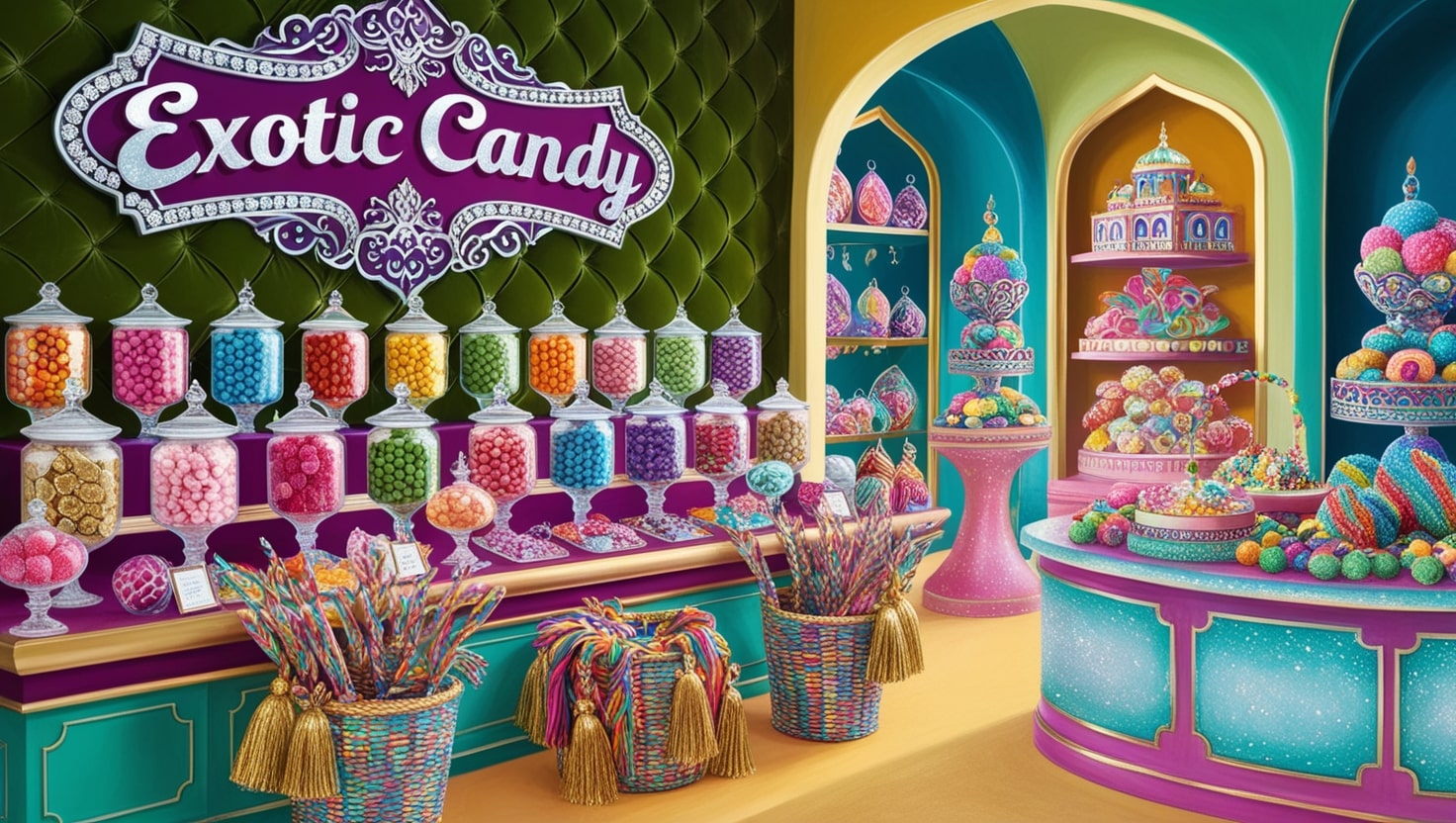Candy lovers everywhere are always on the hunt for something new, something different, and something that excites their taste buds. This is where exotic candy comes into play. But what exactly is exotic candy? Simply put, it’s candy that offers unusual flavors, unique ingredients, or hails from a distant part of the world.
These treats break the mold of the typical sweets you’re used to, offering an adventurous alternative for candy enthusiasts.
As globalization and social media continue to connect people across cultures, exotic candy has grown in popularity. People love discovering new and unfamiliar flavors, whether for the excitement, nostalgia, or simply because it’s fun to try something different.
What Makes Candy Exotic?
Exotic candy stands out from the standard gummies or chocolates you find at your local store. But what makes it truly “exotic”?
- Unusual Ingredients: Ingredients that are uncommon in mainstream candies, like seaweed or chili powder, make candy feel more unique. For example, Japanese candies often feature matcha (green tea) or yuzu (a citrus fruit), while Mexican sweets frequently incorporate spicy elements like tamarind and chili.
- Unique Flavors: Exotic candies often blend sweet, salty, sour, and spicy flavors in unexpected ways. Think of a candy that mixes fruit with spicy undertones, or a sweet treat with a savory twist—these elements make exotic candy intriguing and memorable.
- Rare Sources: Some candies are hard to find or are only available in certain regions of the world. Their rarity can add to their allure. For instance, trying a specific candy from Japan, Italy, or South Korea can make the experience feel special and adventurous.
The Global Appeal of Exotic Candy
Exotic candy doesn’t just come from one part of the world. It’s influenced by the cultures and traditions of different countries, each bringing its own twist on how candy is made and enjoyed. A trip through global candy aisles reveals a fascinating variety:
- Asia: Known for its playful textures and innovative flavors, Asia (especially Japan and Korea) produces candies like mochi, gummies infused with herbal flavors, or even seaweed-wrapped snacks.
- Latin America: Mexican candy lovers will tell you that tamarind, chili, and lime are central to the experience. Spicy, tangy, and sweet combinations dominate this region’s candy market.
- Europe: European countries like Italy, Turkey, and France offer treats like nougat, marzipan, and Turkish Delight. These candies are often more subtle in flavor and texture compared to the boldness of Asian or Mexican varieties.
Popular Exotic Candies Around the World
Japan: Home to matcha Kit-Kats, mochi balls, and a variety of gummy and soda-flavored candies, Japanese candy is known for its creativity and vibrant packaging.
Mexico: Pulparindo, a tamarind-flavored candy with a spicy kick, is a perfect example of how Mexican candy blends flavors. Another favorite is the mango chili lollipops that offer a sweet yet fiery punch.
Turkey: Turkish Delight, or lokum, is a chewy, gel-like confection often flavored with rosewater, lemon, or nuts. This candy is soft, subtly flavored, and very different from Western sweets.
Italy: Italian nougat, known as torrone, is a rich and chewy treat made with honey, nuts, and egg whites, offering a luxurious flavor that’s a step away from typical chocolates and candies.
The Role of Texture in Exotic Candy
Texture plays a huge role in how we enjoy candy, and exotic varieties take full advantage of this. Whether it’s the chewy, pillowy feel of mochi, the crunch of nut-filled nougat, or the surprising burst of a jelly-filled treat, texture elevates the overall experience. In many cases, the texture is just as important as the flavor when it comes to exotic candy.
Why People Are Drawn to Exotic Candy
Ever wonder why someone would choose an unfamiliar candy over a reliable favorite? Here’s why:
- Nostalgia: For people who grew up in a certain country, exotic candy can be a comforting taste of home.
- Curiosity: Some people just love trying new things. Exotic candies offer a sense of adventure.
- Social Media: The viral nature of exotic candy tasting challenges on platforms like TikTok and Instagram has only added to the demand.
Unusual Ingredients in Exotic Candies
If you’ve ever had a wasabi-flavored Kit-Kat or a seaweed-wrapped candy, you know that exotic candies often come with ingredients you wouldn’t expect. Some of the most unusual ingredients include:
- Matcha (Japan) – Ground green tea that gives candies an earthy, slightly bitter taste.
- Chili Peppers (Mexico) – Often combined with fruit, it adds a spicy kick to sweets.
- Licorice (Northern Europe) – A love-it-or-hate-it flavor that has a strong, herbal quality.
Candy Packaging and Marketing: A Global Perspective
Beyond the flavors, packaging can also make a candy feel exotic. In many cultures, candy packaging reflects local traditions, colors, and artwork. For example, Japanese candy often comes in fun, colorful, and sometimes anime-themed packages that are just as collectible as the candy inside.
Where to Find Exotic Candy
Thanks to globalization, exotic candy is now more accessible than ever. Specialty stores and international markets offer a wide selection, while online shops like Amazon and World Market make it easy to buy from anywhere in the world.
Health Considerations with Exotic Candy
While exotic candy is exciting, it’s important to read labels, especially if you have food allergies. Some candies may contain ingredients like nuts, shellfish, or allergens not common in mainstream sweets.
Homemade Exotic Candy
Want to try making your own exotic candy? Simple recipes for treats like Turkish Delight or matcha-flavored chocolate truffles can bring the taste of another culture to your kitchen.
The Cultural Importance of Exotic Candy
In many countries, candy plays a role in festivals and celebrations. In Mexico, for instance, candy is integral to Dia de los Muertos celebrations, while in Japan, sweets are often given during New Year’s as a token of good luck.
The Future of Exotic Candy
As consumer tastes evolve, so does exotic candy. Current trends include the rise of vegan, organic, and gluten-free options, ensuring that there’s something for everyone.
The Role of Social Media in Popularizing Exotic Candy
Social media platforms like TikTok and YouTube have made exotic candy a viral sensation, with influencers posting unboxing videos and taste tests of everything from sour plum candy to soda-flavored gummies.
Conclusion
Exotic candy opens up a whole new world of flavors, textures, and experiences. Whether you’re a seasoned candy connoisseur or someone looking to try something new, these sweet treats provide an exciting glimpse into different cultures and traditions.
FAQs
- What makes a candy “exotic”? Exotic candies are unique in flavor, texture, or ingredients and often come from different parts of the world.
- Where can I buy exotic candy? You can find exotic candy in specialty stores, international markets, or online retailers like Amazon.
- Are exotic candies safe for people with food allergies? Always check the ingredients, as some exotic candies may contain unfamiliar allergens.
- What are the most popular exotic candies in the U.S.? Japanese mochi, Mexican spicy tamarind candy, and Turkish Delight are widely loved.
- How can I introduce exotic candy to my kids? Start with mild flavors, like fruity Japanese gummies, and slowly introduce them to more adventurous tastes!


Hey there! Do you know if they make any plugins
to help with Search Engine Optimization? I’m trying to get my blog to rank
for some targeted keywords but I’m not seeing very good gains.
If you know of any please share. Many thanks! You can read similar blog here:
Eco product
plugin is not a ranking factor. Use neuron writer to optimize articles for ranking and do off page seo.